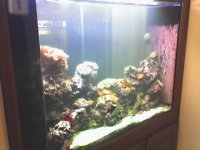A
Anonymous
Guest
Just wanted to "show off" a tank I have been maintaining for the last 6 months. It is one of those "how in the heck does this tank look like this" tanks, based on the system and maintenance. It's just been cleaned, and I took it with a phone camera, so excuse the quality of the image.
A quick run down of the system and inhabitants:
100 gallons
All WCs done with tap water and Instant Ocean salt. 10 gallons biweekly.
Top off with RO/DI water. About 2-3 gallons a week.
Ca/Alk supplied by B-Ionic, weekly doses of about a cup.
No refugium.
A single pump for water return and flow, a Rio something that does about 600 gph.
2 96W PC lights. One actinic one 10000K.
AquaC EV skimmer
No feeding besides flake for the fish.
The impressive parts:
The frogspawn on the left side of the photo has grown to its current size, about the size of a dinner plate, over the last 4 years from a single head.
Same with the bubble coral, just to the right of it.
The tank has a Linckia sp. star that has been there at least 3 years.
Obviously coralline algae grows just fine.
I might scrape the algae off the glass once a month, and it's usually coralline algae.
A quick run down of the system and inhabitants:
100 gallons
All WCs done with tap water and Instant Ocean salt. 10 gallons biweekly.
Top off with RO/DI water. About 2-3 gallons a week.
Ca/Alk supplied by B-Ionic, weekly doses of about a cup.
No refugium.
A single pump for water return and flow, a Rio something that does about 600 gph.
2 96W PC lights. One actinic one 10000K.
AquaC EV skimmer
No feeding besides flake for the fish.
The impressive parts:
The frogspawn on the left side of the photo has grown to its current size, about the size of a dinner plate, over the last 4 years from a single head.
Same with the bubble coral, just to the right of it.
The tank has a Linckia sp. star that has been there at least 3 years.
Obviously coralline algae grows just fine.
I might scrape the algae off the glass once a month, and it's usually coralline algae.






